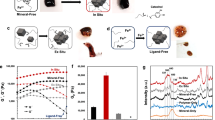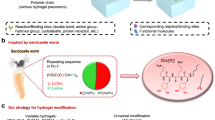Abstract
Polymeric materials that intrinsically heal at damage sites under wet or moist conditions are urgently needed for biomedical and environmental applications1,2,3,4,5,6. Although hydrogels with self-mending properties have been engineered by means of mussel-inspired metal-chelating catechol-functionalized polymer networks7,8,9,10, biological self-healing in wet conditions, as occurs in self-assembled holdfast proteins in mussels and other marine organisms11,12, is generally thought to involve more than reversible metal chelates. Here we demonstrate self-mending in metal-free water of synthetic polyacrylate and polymethacrylate materials that are surface-functionalized with mussel-inspired catechols. Wet self-mending of scission in these polymers is initiated and accelerated by hydrogen bonding between interfacial catechol moieties, and consolidated by the recruitment of other non-covalent interactions contributed by subsurface moieties. The repaired and pristine samples show similar mechanical properties, suggesting that the triggering of complete self-healing is enabled underwater by the formation of extensive catechol-mediated interfacial hydrogen bonds.
This is a preview of subscription content, access via your institution
Access options
Subscribe to this journal
Receive 12 print issues and online access
$259.00 per year
only $21.58 per issue
Buy this article
- Purchase on Springer Link
- Instant access to full article PDF
Prices may be subject to local taxes which are calculated during checkout




Similar content being viewed by others
References
White, S. R. et al. Autonomic healing of polymer composites. Nature 409, 794–797 (2001).
Ghosh, B. & Urban, M. W. Self-repairing oxetane-substituted chitosan polyurethane networks. Science 323, 1458–1460 (2009).
Chen, X. X. et al. A thermally re-mendable cross-linked polymeric material. Science 295, 1698–1702 (2002).
Cordier, P., Tournilhac, F., Soulie-Ziakovic, C. & Leibler, L. Self-healing and thermoreversible rubber from supramolecular assembly. Nature 451, 977–980 (2008).
Dailey, M. M. et al. A self-healing biomaterial based on free-radical polymerization. J. Biomed. Mater. Res. http://dx.doi.org/10.1002/jbm.a.34975 (2013).
Boger, A., Heini, P., Windolf, M. & Schneider, E. Adjacent vertebral failure after vertebroplasty: A biomechanical study of low-modulus PMMA cement. Eur. Spine J. 16, 2118–2125 (2007).
Holten-Andersen, N. et al. pH-induced metal–ligand cross-links inspired by mussel yield self-healing polymer networks with near-covalent elastic moduli. Proc. Natl Acad. Sci. USA 108, 2651–2655 (2011).
Krogsgaard, M., Behrens, M. A., Pedersen, J. S. & Birkedal, H. Self-healing mussel-inspired multi-pH-responsive hydrogels. Biomacromolecules 14, 297–301 (2013).
Shafiq, Z. et al. Bioinspired underwater bonding and debonding on demand. Angew. Chem. Int. Ed. 51, 4332–4335 (2012).
Zeng, H., Hwang, D. S., Israelachvili, J. N. & Waite, J. H. Strong reversible Fe3+-mediated bridging between dopa-containing protein films in water. Proc. Natl Acad. Sci. USA 107, 12850–12853 (2010).
Holten-Andersen, N., Fantner, G. E., Hohlbauch, S., Waite, J. H. & Zok, F. W. Protective coatings on extensible biofibres. Nature Mater. 6, 669–672 (2007).
Carrington, E. & Gosline, J. M. Mechanical design of mussel byssus: Load cycle and strain rate dependence. Am. Malacol. Bull. 18, 135–142 (2004).
Yu, J. et al. Mussel protein adhesion depends on interprotein thiol-mediated redox modulation. Nature Chem. Biol. 7, 588–590 (2011).
Heo, J. et al. Improved performance of protected catecholic polysiloxanes for bioinspired wet adhesion to surface oxides. J. Am. Chem. Soc. 134, 20139–20145 (2012).
Menyo, M. S., Hawker, C. J. & Waite, J. H. Versatile tuning of supramolecular hydrogels through metal complexation of oxidation-resistant catechol-inspired ligands. Soft Matter. 9, 10314–10323 (2013).
Sedó, J., Saiz-Poseu, J., Busqué, F. & Ruiz-Molina, D. Catechol-based biomimetic functional materials. Adv. Mater. 25, 653–701 (2013).
Belman, N., Jin, K. J., Golan, Y., Israelachvili, J. N. & Pesika, N. S. Origin of the contact angle hysteresis of water on chemisorbed and physisorbed self-assembled monolayers. Langmuir 28, 14609–14617 (2012).
Eslami, M., Zare, H. R. & Namazian, M. Thermodynamic parameters of electrochemical oxidation of L-DOPA: Experimental and theoretical studies. J. Phys. Chem. B 116, 12552–12557 (2012).
Lee, B. P., Messersmith, P. B., Israelachvili, J. N. & Waite, J. H. in Annual Review of Materials Research Vol. 41 (eds Clarke, D. R. & Fratzl, P.) 99–132 (Annual Reviews: Palo Alto, 2011).
Yu, J. et al. Adaptive hydrophobic and hydrophilic interactions of mussel foot proteins with organic thin films. Proc. Natl Acad. Sci. USA 110, 15680–15685 (2013).
Zhang, J. et al. Real-space identification of intermolecular bonding with atomic force microscopy. Science 342, 611–614 (2013).
Aviram, A., Seiden, P. E. & Ratner, M. A. in Molecular Electronic Devices (ed. Carter, F. L.) 5–17 (Marcel Dekker, 1983).
Tylli, H. & Konschin, H. A Raman spectroscopic study of the OH and OD torsion in 1,2-dihydroxybenzene. J. Mol. Struct. 57, 13–19 (1979).
Navarrete, J. T. L. & Ramírez, F. J. A study by Raman spectroscopy and the semiempirical AM1 method on several 1,2-dihydroxybenzene solutions. Spectrochim. Acta A 49, 1759–1767 (1993).
Hemraj-Benny, T. et al. Near-edge X-ray absorption fine structure spectroscopy as a tool for investigating nanomaterials. Small 2, 26–35 (2006).
Park, J. et al. Structural characterization of conjugated polyelectrolyte electron transport layers by NEXAFS spectroscopy. Adv. Mater. 20, 2491–2496 (2008).
Lee, D. W., Lim, C., Israelachvili, J. N. & Hwang, D. S. Strong adhesion and cohesion of chitosan in aqueous solutions. Langmuir 29, 14222–14229 (2013).
Anderson, T. H. et al. The contribution of DOPA to substrate–peptide adhesion and internal cohesion of mussel-inspired synthetic peptide films. Adv. Funct. Mater. 20, 4196–4205 (2010).
Danner, E. W., Kan, Y. J., Hammer, M. U., Israelachvili, J. N. & Waite, J. H. Adhesion of mussel foot protein Mefp-5 to mica: An underwater superglue. Biochemistry 51, 6511–6518 (2012).
Wang, J. et al. Influence of binding-site density in wet bioadhesion. Adv. Mater. 20, 3872–3876 (2008).
Ahn, B. K., Kraft, S. & Sun, X. S. Chemical pathways of epoxidized and hydroxylated fatty acid methyl esters and triglycerides with phosphoric acid. J. Mater. Chem. 21, 9498–9505 (2011).
Ahn, B. K., Kraft, S., Wang, D. & Sun, X. S. Thermally stable, transparent, pressure-sensitive adhesives from epoxidized and dihydroxyl soybean oil. Biomacromolecules 12, 1839–1843 (2011).
Bunker, S. P. & Wool, R. P. Synthesis and characterization of monomers and polymers for adhesives from methyl oleate. J. Polym. Sci. Polym. Chem. 40, 451–458 (2002).
Israelachvili, J. et al. Recent advances in the surface forces apparatus (SFA) technique. Rep. Prog. Phys. 73, 036601 (2010).
Lee, D. W., Banquy, X. & Israelachvili, J. N. Stick–slip friction and wear of articular joints. Proc. Natl Acad. Sci. USA 110, E567–E574 (2013).
Acknowledgements
The authors gratefully acknowledge financial support from the Office of Naval Research N000141310867, the United Soybean Board, the Institute for Collaborative Biotechnologies through grant W911NF-09-0001 from the US Army Research Office (the content of the information does not necessarily reflect the position or the policy of the Government, and no official endorsement should be inferred), the National Science Foundation MRSEC DMR-1121053, and the US Department of Energy, Office of Basic Energy Sciences, Division of Materials Sciences under Award DE-FG02-87ER-45331 (J.N.I. for the instrument modification of the Surface Forces Apparatus for the adhesion measurements and D.W.L. for the adhesion measurements). The authors also acknowledge assistance from T. Mates for XPS, Y. Li for XRR, and L. Perez for NEXAFS and GIWAXS.
Author information
Authors and Affiliations
Contributions
B.K.A. and D.W.L designed the research, performed the experiments, and wrote the paper. J.N.I. advised the experimental design of the modified SFA and experimental measurements, and the interpretation of results. J.H.W. supervised the overall experimental design and writing.
Corresponding authors
Ethics declarations
Competing interests
The authors declare no competing financial interests.
Supplementary information
Supplementary Information
Supplementary file (PDF 1358 kb)
Rights and permissions
About this article
Cite this article
Ahn, B., Lee, D., Israelachvili, J. et al. Surface-initiated self-healing of polymers in aqueous media. Nature Mater 13, 867–872 (2014). https://doi.org/10.1038/nmat4037
Received:
Accepted:
Published:
Issue Date:
DOI: https://doi.org/10.1038/nmat4037
This article is cited by
-
Self-Healing Polymer a Dynamic Solution in Food Industry: a Comprehensive Review
Food Biophysics (2024)
-
Synthesis of branched and benzyl chlorine-free poly(4-acetoxystyrene) via living polymerization followed by Friedel–Crafts alkylation
Polymer Bulletin (2023)
-
Programmable living assembly of materials by bacterial adhesion
Nature Chemical Biology (2022)
-
A self-healing water-dissolvable and stretchable cellulose-hydrogel for strain sensor
Cellulose (2022)
-
Hydrogel tapes for fault-tolerant strong wet adhesion
Nature Communications (2021)



